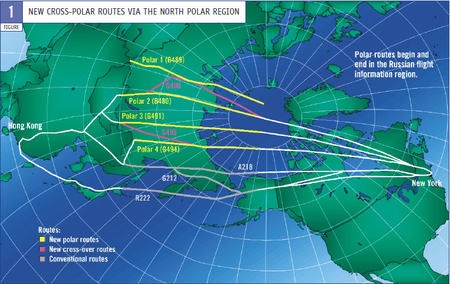My brother left for Bangkok (via Hong Kong) on a Cathay Pacific flight the other day. Before he left, we had a discussion as to which way the aircraft would fly from Toronto to get to Hong Kong.
We were both arguing either west bound or east bound. We were both wrong!
I was tracking the flight on Flight Aware and saw their planned routing. Right over the North Pole!
V34 YEE J557 YSB 5000N 07952W YGL 5500N 07656W 6000N 07400W 6500N 07200W 7000N 06900W MEDPA 8000N 06000W 8500N 04000W ABERI B934 BINTA B934 USATO B934 MX B155 TUNIR A45 USONA G490 LIRTA G490 SERNA M520 POLHO G218 TMR B458 KR B458 WXI A461 LKO A461 LIG R473 WYN W18 NLG W23 ZUH
(Imagine typeing all that in your FMS)
I didn’t think the necessary infrastructure was in place to allow flights like this. Specifically alternate airports. However I learned that is not the only issue to worry about.
Boeing has a document that describes in detail what is needed for flying the Polar Routes. Some main issues:
- Fuel Freezing
- Cosmic radiation (especially during solar flares)
- Lack of magnetic compass reliability
- Communication (VHF/HF) problems
There is some political contention with these routes though. Traditional routes were long enough and aircraft were less fuel efficient in the past that caused airliners to have a refuelling stop in Russia. This resulted in the sale of over $20M in jet fuel to foreign airliners back in 1997.
As a way to recoup some of the lost jet fuel sales, in 1999 Russia wanted to increase the rate at which airliners pay to fly through Russias airspace. Their justification was that the increase cost would eventually pay for more infrastructure in the Russian FIR, especially in the northern polar regions. At the time radar coverage as not available in the far north. This has since changed as the new fee structure initiated in 1999 pulled in an estimated $70M.



